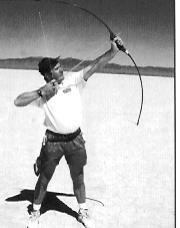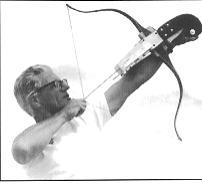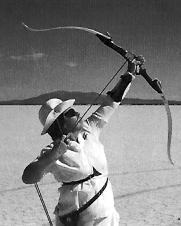World Record archer, Barry Groves, article on Flight Archery — the Pursuit of Perfection

Introduction
One of the first things any boy does with a piece of bent bamboo, a string and
an 'arrow' — which is usually another piece of bamboo, thinner than the
first and, with a bit of selection, straighter — is see how far he can
shoot it. This is Flight archery in its simplest form.
Flight is the only form of archery which doesn't involve a target. Or it has
the biggest target — the Earth — depending on how you look at it.
It is ironic that this first type of archery for children has the fewest
adherents among adults. Yet it is Flight archery that is at the cutting edge.
Without Flight, archery generally would be much poorer. For Flight archery is
the 'Formula One' of archery. Like a Grand Prix car, dedicated Flight bows are
not built for the reliability needed for 150 arrow FITAs, week after week, year
after year. The dedicated Flight bow is built to shoot an arrow as far as
possible — that's it! The Flight bow is refined to its ultimate, stressed
to the limit, strings with as few strands as possible for lightness, and with
arrows hand-made for aerodynamic perfection. It is in Flight archery that
tuning and technique are all-important. To win at Flight nothing less than
perfection is good enough.
The five facets of Flight
I have divided Flight archery into five different but interdependent facets: the bow, arrows, tuning, technique and, lastly, somewhere to practise.

The bow
Any archer can shoot Flight. No special equipment is needed as Flight rules have classes for all types of bow from longbow to Flight bow, recurve to compound, or even crossbow. The Target archer, therefore, can shoot Flight and many do.

With an 'off-the-shelf' Target or Field bow the amount that can be done to
increase its performance is limited. In essence the faster an arrow leaves a
bow, the further it will travel. The aim with the bow, therefore, is increasing
its efficiency so that as little energy as possible is used to move the limbs
or overcome friction, and as much of the stored energy as possible is used to
accelerate the arrow. With the Target bow this is usually restricted to
modifying the bracing height and draw length. The weight (mass) of what the bow
is moving also has a large bearing on how quickly it will accelerate, so weight
of the moving parts — limbs, cams, arrows, even string — also plays
a significant role. Bows used specifically for Flight invariably have thinner,
shorter and, therefore, lighter limbs and strings. With the compound bow, other
areas to concentrate on are the size and weight of the cams and friction in the
axles and cable guard.
Because Flight bows are very short, and the arrows shot are of the order of 14
to 15 inches in length, they are usually fitted with a handle in front of the
riser.

And as they are centre shot, using a release aid, their risers normally have a
hole in the centre through which the arrow passes (see picture, right).
Dedicated Flight bows, both recurve and compound, are available commercially
but, as there is a limited market for them, there are very few manufacturers
and they tend to be expensive.
Arrows
Arrows should be as light as possible. They should also cause as little
friction through the air as possible. Easton ACEs are excellent arrows for the
target archer shooting Flight. To keep the air friction down, fletches should
be as small as possible. But there is a trade-off here in that while smaller
fletches reduce friction, they also reduce stability, and stability in flight
is also an important consideration. And do not forget, these must be regular
Target arrows.
Target bows are allowed a certain amount of overdraw. Use it — to shoot
shorter and, therefore, lighter arrows.
Dedicated Flight arrows cannot be bought. They are generally made from 3 mm or
4 mm solid carbon rod by the archers who shoot them. They are invariably
barrelled to some extent, have centres of gravity around or just in front of
the mid point of the arrow, and fletches which measure no more than 6-8 mm in
any direction. Points and nocks are made from pieces of 3-4 mm aluminium rod
(knitting pins are ideal), and fletches from bits of computer floppy disk,
stuck on with Superglue. Until the advent of computers they were generally made
from razor blades.
Arrow rests.
On a Target bow you will use your normal arrow rest and pressure button.
However, the Flight bow is allowed an overdraw as far back as the string on a
compound, and as far back as you like on a conventional recurve. This means
that the string is going to follow the arrow through the arrow rest; which
means in turn that this has to be something which will not impede the arrow's
progress or deflect the string.
The commonest arrow rest is some form of brush — toothbrush or small
paintbrush — with the arrow very delicately balanced on it. I managed to
graze my arm with one — it is not for the nervous archer. I favour Ted
Mallett's invention: a piece of thin balsa wood with a notch cut in the centre.
This is safer as the arrow cannot fall off, but has the disadvantage that it is
broken with every shot and can only be used once.
Tuning
Tuning of arrows to bows was never more important than in Flight. When the arrow leaves the bow it is travelling at its fastest. Even the slightest deviation from straight at this point will slow it down no end. It is essential, therefore, that the arrows are correctly spined and tuned to the bow. And don't forget that stabilizers can be tuned too. Stabilizers fitted to a bow so that you don't have to buy a bowstand, may not be set up to their best.
Technique
Shooting technique ties in with bow tuning. Without good shooting form the arrow will not come out of the bow straight. You can get away with a less than perfect technique in Target archery: if the arrow leaves the bow sideways, the fletches will correct it, and the arrow will hit the target. But that won't do in Flight. In California in 1996, my wife was helping me (see below) by making sure I was pointed in the right direction. It was "right a bit . . .left a bit . . .". On one of my shots she said "okay" just as I loosed. My concentration was disturbed at that moment. As a consequence that arrow only went 350 yards — the others were all over 800.
Releases.
To reduce archer's paradox and allow a straight arrow flight, all archers using conventional Flight bows are allowed to use releases. These are generally handmade from strips of leather and rubber. Target compound archers can use their regular release aids, either wrist or hand held, but compound Flight archers' releases must be hand held.
Somewhere to practise
And so to the problem of finding somewhere to practise: a problem I have yet to resolve. As I have shot over a kilometre, not only do I need something like an airfield, I need one with very short grass or I cannot find the arrows. However, for the Target archer practising Flight it is easier. A good Target bow, shot well, will make 400-500 yards; a longbow considerably less. And as Target arrows are much bigger, they are not so difficult to lose. A large field or two fields together may suffice. I started shooting Flight on a local golf course — across three fairways and along a fourth I had a total of 650 yards of well-trimmed grass to play with. The only disadvantage is that golfers always seem to get out at dawn and you can't shoot when they are around.
Assistance
Unlike in other forms of archery, Flight archers are allowed to have an
assistant. Normally the assistant helps the archer by telling him when he is at
the correct angle. Most commonly this is done using a 45 trisquare which is
lined up with the arrow and the horizon. More sophisticated ones may have a
plumb bob in case there is no convenient flat horizon. I prefer to use my own
judgement rather than someone else's and fit my bows with spirit levels.
Do not worry if you attend a Flight tournament on your own, there is invariably
someone there who will be happy to assist you.
The angle of the dangle.
The optimum angle to shoot at for distance is theoretically 45 degrees. However, as
the arrow slows down as it travels due to friction through the air, the
flightpath is not symmetrical and it is better to shoot at just under 45. If
you are shooting with the wind, aim a degree or so higher; if against it, a
degree or so lower.
In the USA Flight is always shot with the wind. In Britain we always seem to
shoot across or against the wind — and rain too!
More angles.
When the distances of the shots are measured, it is along a preset line laid
out on the ground. If your shot lands off to the side, you will forfeit some of
the distance your arrow has actually travelled. So as well as looking into the
sky to get the angle of elevation correct, you also have to gauge your angle of
azimuth so that the arrow lands as near the line as possible. So I lied: you do
have a sort of target after all! If you are shooting directly with a slight
wind, as in the USA, this is not too difficult. But if you are shooting in
North Yorkshire on a typical day, you have to get some idea of what the wind is
doing 1,000 feet and more up. That's a lot more fun.
Tournament Strategy
Only one arrow is going to count — the furthest one. In the USA, only one
end of six arrows is shot in any one Class — and there are no sighters in
Flight. So you have just six chances to get it right. In a British Flight
tournament normally four ends of six arrows each are shot, which makes life
easier.
If you are trying Flight for the first time with your Target bow, you will be
in competition with others using similar bows, which will have similar
characteristics and shoot similar arrows a similar distance. To be the one who
wins, you have to be just that bit better than the competition. The most
important thing to aim for is the perfect loose and the perfectly straight
arrow. Get this right and, not only will it help you win at Flight, it will
also improve you scores in Target, Field and Clout.
A sport for all
Bows for which there are classes include not only dedicated Flight bows but
also Target recurve bows, longbows and compounds, with separate classes for
men, women, boys and girls, so all are catered for.
And we Brits are good at it: Britain has more World Record holders in Flight
than in any other discipline. As an example, there were no fewer than seven
World Record holders at the 2002 West Midlands Championships. And that is
really a relatively small local Flight shoot.

Distances shot
The furthest distance shot with any bow is
2,047 yards (1,871.84m)
. This was shot by the late Harry Drake in 1988 using a crossbow. The furthest
with a hand-held — and pulled — bow is
1,336 yds 1' 3" (1,222.01m)
, shot by Don Brown with an unlimited conventional Flight bow in 1987. My 40kg
Compound World Record of
1,162 yards
was made shooting a 30 kg bow — I can't pull 40 kg!
Distances achieved in Britain include:
Conventional Flight Bow (unlimited): Alan Webster — 916 yards
Compound Flight Bow (60 lbs): Barry Groves - 914 yards. That distance has since been beaten
Last updated 30 January 2003
Related Articles

 HOME
HOME


